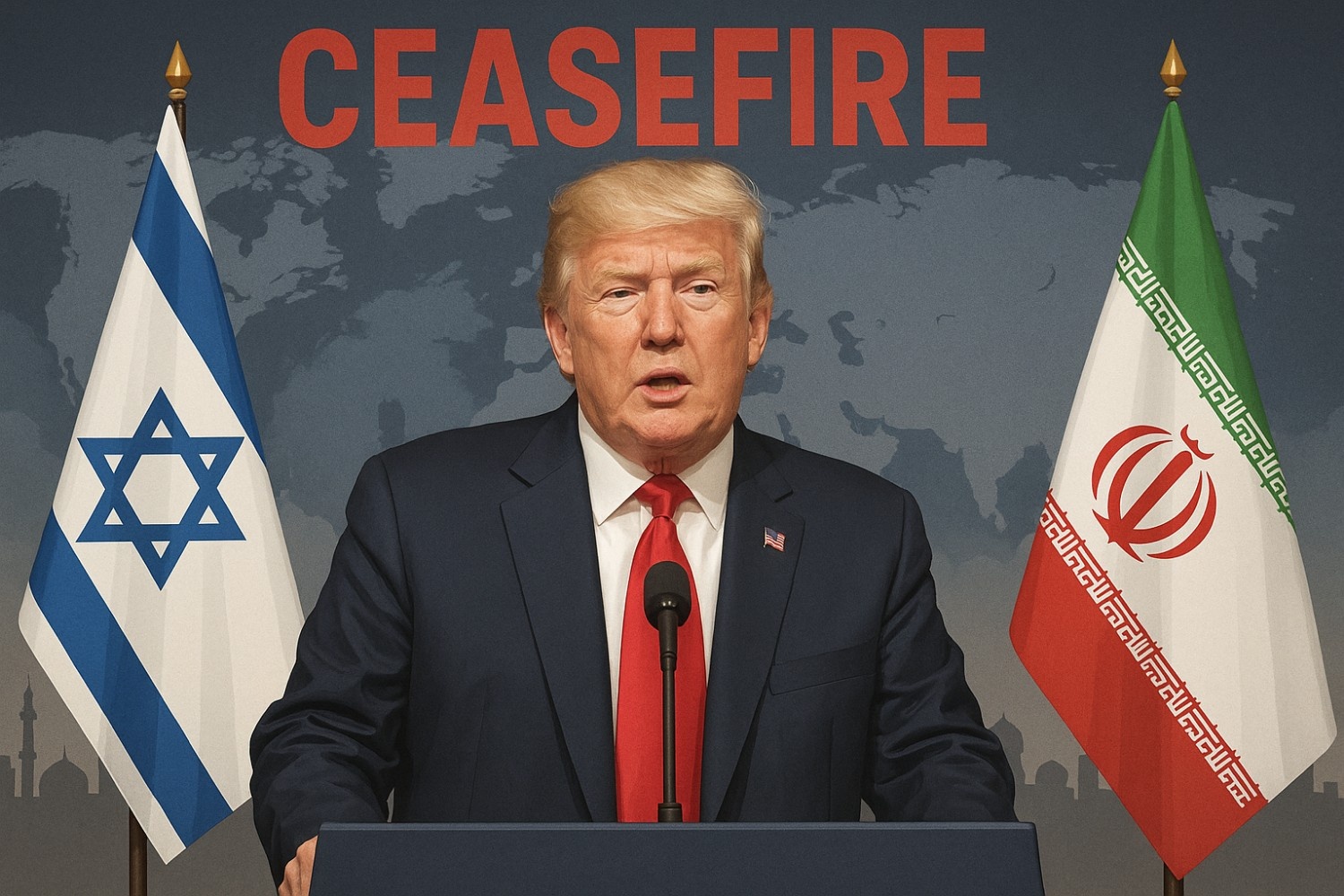On June 24, 2025, U.S. President Donald Trump announced a ceasefire between Israel and Iran, aiming to end a 12-day conflict that raised fears of a broader Middle East war. This article breaks down the ceasefire details, its timeline, global reactions, and what it means for the region. We provide clear, reliable information to help you understand this historic moment.
What Happened in the Israel-Iran Conflict?
The conflict began 12 days before Trump’s announcement, sparked by Israeli strikes on Iran’s nuclear facilities. Iran retaliated with missile attacks, including one on a U.S. military base in Qatar. Tensions escalated as both nations exchanged strikes, causing casualties and global concern. At least four people died in Beersheba, Israel, due to Iranian missile strikes, while Israeli attacks killed nine in Iran’s Gilan province.
The U.S., under Trump’s leadership, stepped in to mediate. Qatar played a key role in negotiations, helping secure Iran’s agreement. Trump called the conflict the “12-day war” and pushed for a “complete and total ceasefire” to prevent further escalation.
Key Events Leading to the Ceasefire
- Israeli Strikes: Israel targeted Iran’s nuclear sites, aiming to disrupt its nuclear program.
- Iran’s Response: Iran launched missiles at Israel and a U.S. base in Qatar, retaliating for U.S. and Israeli actions.
- Trump’s Mediation: Trump, alongside Vice President JD Vance and Qatari leaders, brokered talks with both nations.
- Ceasefire Announcement: On June 24, Trump posted on Truth Social, declaring a phased ceasefire starting within hours.
How Does the Ceasefire Work?
Trump outlined a phased ceasefire plan. Iran would halt attacks first, followed by Israel 12 hours later. The ceasefire would last 24 hours, after which the war would be considered “ended.” Both sides were urged to remain “peaceful and respectful” during this period.
However, confusion arose. Iran’s Foreign Minister Abbas Araghchi stated there was no formal “agreement,” but Iran would stop attacks if Israel ceased by 4 a.m. Tehran time. Israel’s Prime Minister Benjamin Netanyahu confirmed agreement to the ceasefire but warned of a strong response to any violations.
Ceasefire Timeline
| Event | Time |
|---|---|
| Trump’s Announcement | June 24, 2025, 6:02 p.m. ET |
| Iran Halts Attacks | 4 a.m. Tehran time (8:30 p.m. ET, June 23) |
| Israel Joins Ceasefire | 12 hours after Iran |
| Official War End | 24 hours after ceasefire start |
Why Was the Ceasefire Announced?
The ceasefire aimed to de-escalate a conflict that risked destabilizing the Middle East. Trump’s announcement followed intense diplomatic efforts, including talks with Netanyahu and indirect communication with Iran through Qatar. The U.S. sought to protect its interests, especially after Iran’s attack on its Qatar base.
Global leaders feared a prolonged war could disrupt oil supplies and draw in other nations. Brent crude oil prices dropped to $67.17 per barrel after the announcement, reflecting market relief. The ceasefire also responded to calls from the UN and other nations for civilian protection and regional stability.
What Were the Challenges?
Despite Trump’s optimism, challenges persisted:
- Continued Attacks: Iran launched missiles at Israel after the announced deadline, killing four in Beersheba.
- Lack of Clarity: Israel did not immediately confirm the ceasefire, and Iran denied a formal agreement.
- Fragile Trust: Both nations expressed readiness to resume strikes if the other violated the truce.
Global Reactions to the Ceasefire
World leaders and markets reacted swiftly:
- Australia: Assistant Minister Andrew Leigh called the truce “welcome news,” hoping it would lead to regional prosperity.
- Qatar: Qatar’s leadership was praised for its mediation but reserved the right to respond to Iran’s attack on its soil.
- Markets: Oil prices fell, and the Australian dollar rose to a five-day high of 65.06 US cents.
- Iran’s Media: State outlets claimed the ceasefire was “imposed on the enemy,” framing it as a victory.
Social media posts on X reflected mixed sentiments. Some users celebrated Trump’s diplomacy, while others questioned the ceasefire’s durability due to ongoing strikes.
What Does This Mean for the Middle East?
The ceasefire could reshape the region’s dynamics. A successful truce might:
- Reduce immediate violence and civilian casualties.
- Encourage broader peace talks, including on Gaza’s humanitarian crisis.
- Strengthen U.S. influence in Middle East diplomacy.
However, risks remain. Historical ceasefires in the region have been fragile, as noted by Australian Senator Sarah Hanson-Young. If either side resumes attacks, the conflict could escalate again, potentially involving other nations.
Impact on U.S. Foreign Policy
Trump’s role in brokering the ceasefire highlights his administration’s focus on decisive action. By coordinating with Qatar and engaging directly with Israel, Trump positioned the U.S. as a key player in resolving the crisis. His dismissal of European peace efforts underscores a unilateral approach, which may shape future U.S. diplomacy.
Frequently Asked Questions
Is the Israel-Iran Ceasefire Permanent?
The ceasefire is set for 24 hours, after which the war is considered “ended.” However, its permanence depends on both sides adhering to the terms. Violations could restart hostilities.
Why Did Iran Attack a U.S. Base in Qatar?
Iran targeted the Al Udeid Air Base in retaliation for U.S. strikes on its nuclear facilities, which followed Israel’s initial attacks.
Who Mediated the Ceasefire?
Qatar played a crucial role, with Trump and Vice President JD Vance leading U.S. efforts. Israeli Prime Minister Netanyahu and Iranian officials were directly involved.
What Happens if the Ceasefire Fails?
Both Israel and Iran have warned of strong retaliation if the other violates the truce. A failure could lead to renewed strikes and regional instability.
Why This Ceasefire Matters to You
The Israel-Iran ceasefire affects more than just the Middle East. It influences global oil prices, international security, and U.S. foreign policy. For readers, understanding this event helps you grasp its impact on energy costs, travel safety, and global markets. Staying informed empowers you to follow developments and their potential effects on your life.
Stay Updated on the Israel-Iran Ceasefire
The situation remains fluid. Follow trusted Saudi news source for updates on whether the ceasefire holds. You can also check platforms like X for real-time reactions, but verify information with primary sources to avoid misinformation.
This ceasefire is a critical step toward peace, but its success depends on cooperation. Share this article to spread clear, reliable information about this historic moment.
Sources
This article draws on reports from Reuters, Al Jazeera, The Guardian, ABC News, and posts on X for real-time sentiment. All information is cross-checked for accuracy as of June 24, 2025.




